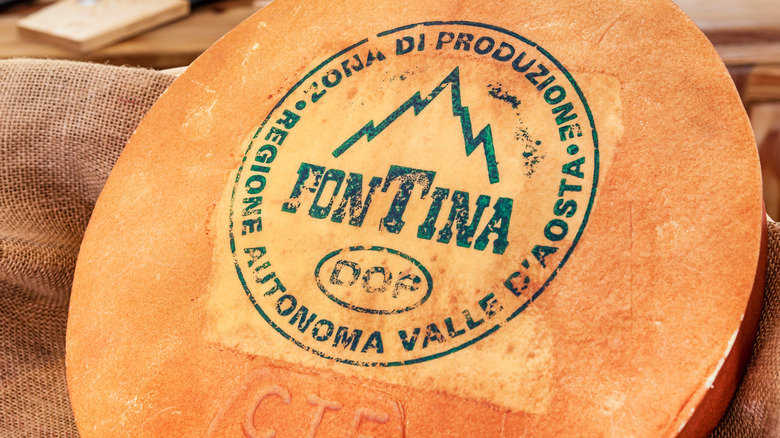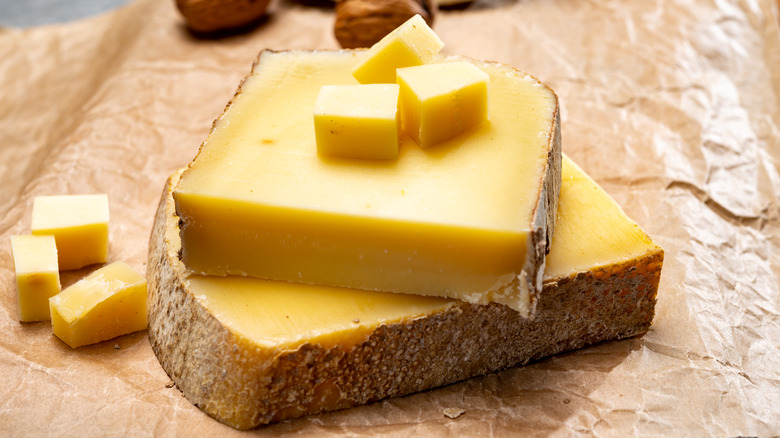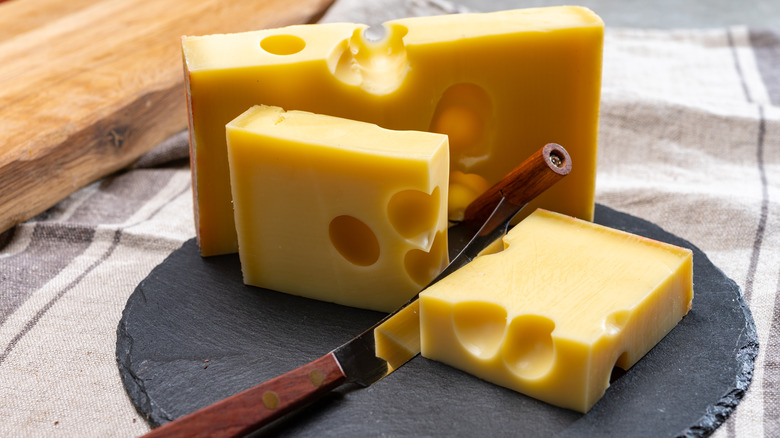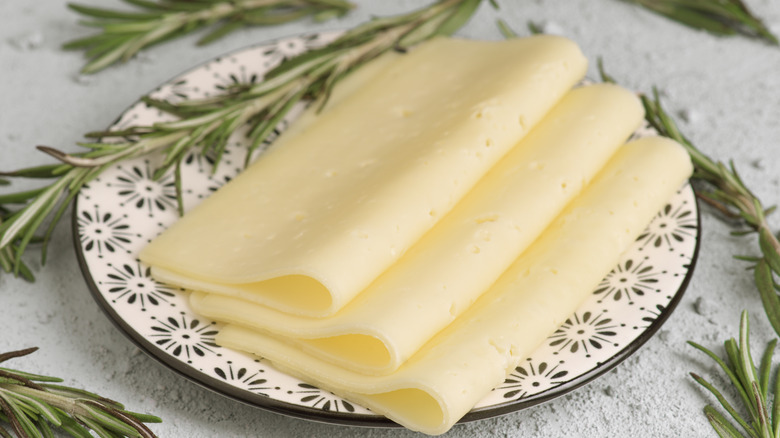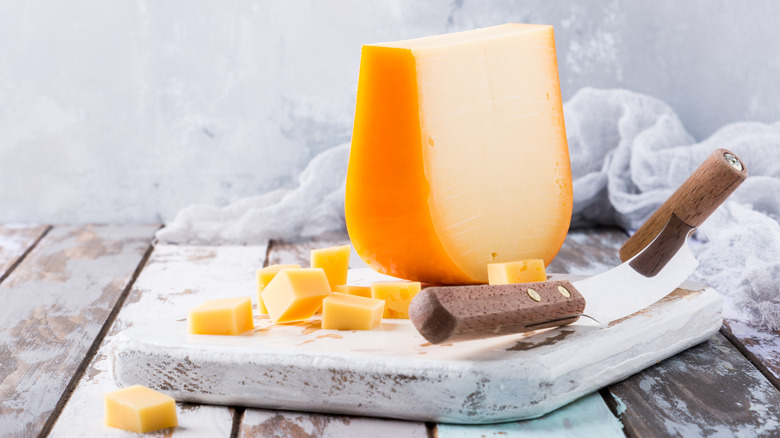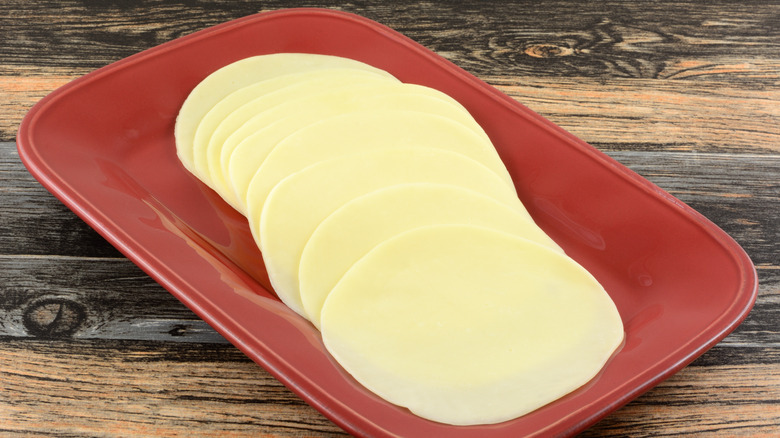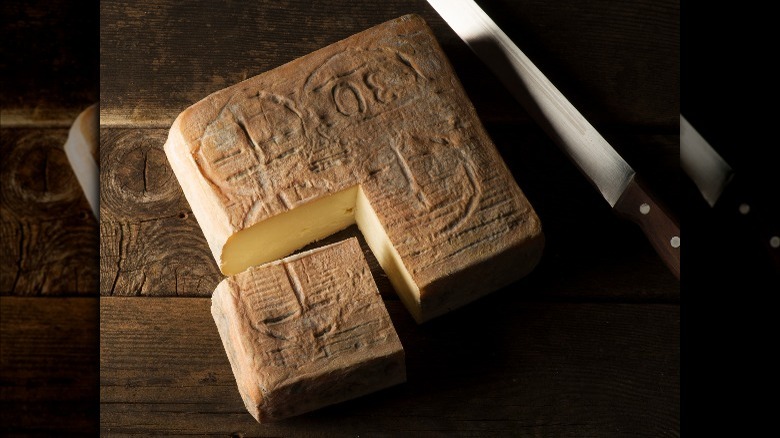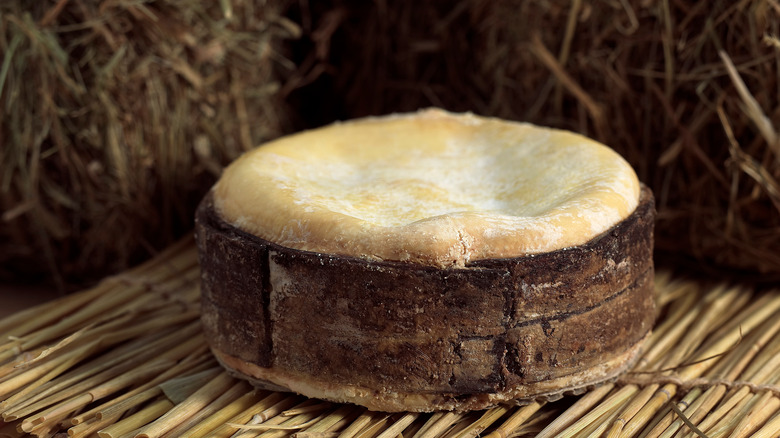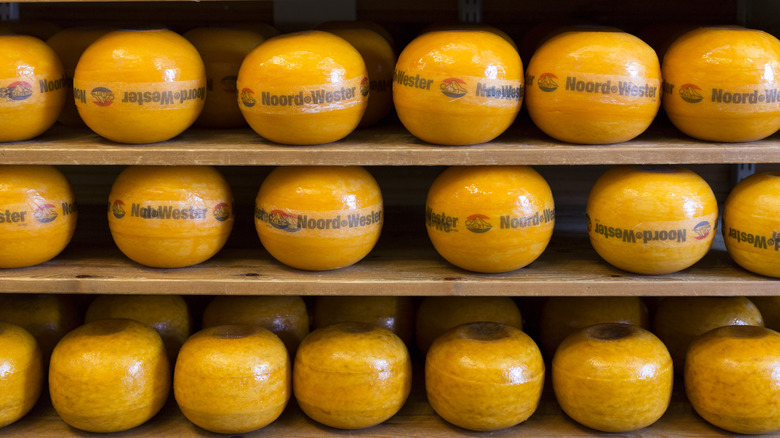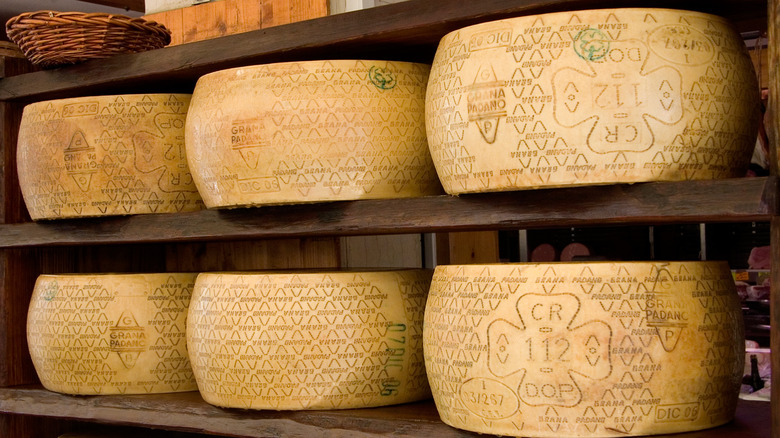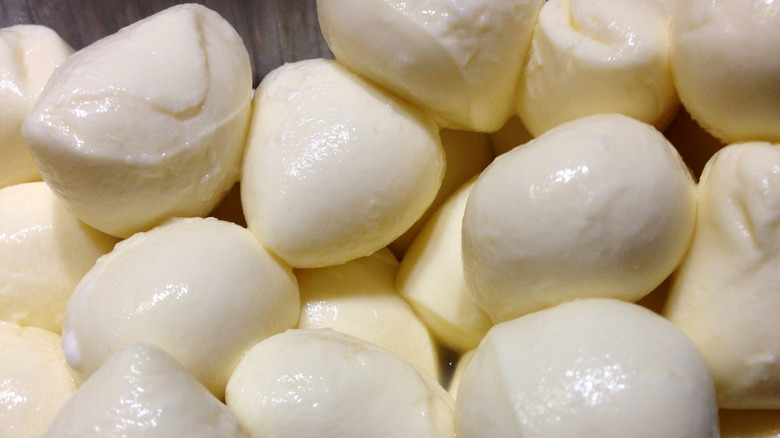The 10 Best Substitutes For Fontina Cheese
Fontina cheese is known for its creamy, buttery flavor that's pretty mild, and it's often used in all kinds of dishes, both hot and cold. The semi-soft cheese is delicious on a sandwich but also makes incredible fondue thanks to its consistency when melted. While fontina cheese is versatile, it can also be easily substituted with plenty of other cheeses you might have on hand that are similar in taste and texture.
That's because Fontina is made like most cheeses. The process begins with milk that is heated so the whey can separate from the curds to be pressed into a mold. The cheese is then brined for two months and aged for another three months. It can also be sourced from several countries. According to Castello Cheese, Fontina hails from Italy, but it is also often made in Denmark and Sweden. So, other cheeses from these countries are typically good substitutes. With the 10 options below, you can easily find alternatives that match whatever quality of Fontina you're looking to emulate, from its mild flavor to its melting abilities.
1. Gruyere
Gruyere is a semi-soft cheese made in its namesake village in Switzerland, and it's one of the best substitutes for Fontina (via Taste Essence). The two cheeses share a similar flavor profile, particularly noticeable with a mature Fontina, which will taste even more buttery and nutty. You'll also notice the textures of the cheeses are quite comparable too.
Gruyere is a cow's milk cheese that's relatively easy to find in most markets and grocery stores. Since Gruyere cheese is most similar to aged Fontina, it is best used in dishes that call for that type. It's great on sandwiches but also hot dishes like pastas, soups, and even casseroles. Though it melts well, Gruyere is not the best alternative for something like fondue — even though it can be used to make cheese sauce. The best idea is to only use Gruyere for many recipes that call for non-melted Fontina.
2. Emmental
Emmental is another Swiss cheese that makes a great substitute for Fontina. It's actually what you likely know as "Swiss cheese," though it comes from its own particular namesake region of the country. This semi-hard cheese is likewise made with cow's milk and is, of course, festooned with holes throughout. The cheese also has a nutty flavor that is even sometimes described as "fruity." It's worth noting that Emmental cheese can have a very strong smell that is off-putting to some.
Emmental cheese should be easy to find or you can easily swap in the Swiss cheese already in your fridge. It's a very versatile option that can be used on sandwiches as well as melted down and used in a pot of fondue. Thanks to its flavor profile, Emmental pairs well with other common charcuterie board items and is a good option for snacking all on its own. It will also melt into a great cheese sauce if that's what you need it for, too.
3. Havarti
Like Fontina and Emmental cheeses, Havarti cheese is also holey though its pores are smaller than those of Emmental cheese and more abundant than those in Fontina. This Danish cow's milk cheese is on the soft side and comes from one of the same countries that makes Fontina cheese, which means it is highly comparable. It shares similar mild, creamy flavors, so it can be easily swapped in for young Fontina in many recipes.
The soft texture allows Havarti cheese to melt easily, too, though it also works well cold. Add it to deli subs or paninis, pasta bakes, or even to cheese boards to be served with a wide variety of complementary wines. Havarti can be easily found at many grocery stores and even comes in a couple of different styles such as pre-sliced for sandwiches or in a wedge so you can cut and prepare it as you need it.
4. Gouda
Just as Emmental cheese has a distinct odor, Gouda has a distinct flavor — especially if it has been smoked. Gouda is a somewhat hard cow's milk cheese that has a different color and texture from Fontina. The cheese comes from the Netherlands and can be used in many different ways, even though it will not totally emulate the same flavor as Fontina cheese.
But, Gouda can be prepared almost any way, from sliced to grated. Its substantial texture and flavor also allow this cheese to work well with many dishes because it can easily stand up to other tastes in the recipe. It works just as well as the other options above for sandwiches and fondue, and Gouda cheese can also be cubed and tossed into pasta bakes for little pockets of dairy or grated over the top for a nice melted layer. Get creative with how you use Gouda, but just know that it will have more of a presence than even aged Fontina.
5. Provolone
Provolone can also be used as an adequate substitute for Fontina, particularly provolone cheese that has not been smoked. Both of these types come from Italy and both are young cheeses with mild flavors, though provolone is even more mild than young Fontina. However, provolone cheese does have a bit of tang that can be noticeable.
Like Havarti or Emmental, provolone cheese is very common in grocery stores and can be found already prepared in many different ways. It works well in many Italian dishes like a topping for baked ziti or as a topping for salads. Try adding it to hot sandwiches like melted on a meatball sub or layered into a grilled cheese. Provolone can even be used to make a great sauce because it melts quite well, too. Because provolone tends to be on the softer side, it doesn't grate as easily. So if you plan to add it to Italian dishes like on top of pasta or in a pizza cheese blend, simply buy it sliced and finely cut it. Or, run a larger piece of cheese through the shredder setting on your food processor.
6. Taleggio
Taleggio is another semi-soft Italian cheese made of cow's milk, which is a great alternative to Fontina. This cheese has a rather bold flavor and smell so it will stand up to other strong cheese personalities. Though Taleggio is soft like a young Fontina, its prominent flavor is more like that of an aged Fontina. Because it embodies traits of both types of Fontina, Taleggio cheese can be used in tons of different dishes as a versatile substitute.
Taleggio is ideal for things like salads and sandwiches or even pizza with some flavor kick. You can slice it or shred it, but this cheese does have a slightly higher percentage of fat content than Fontina, so it does best when it's cut rather than grated. It can also melt really well thanks to that high fat content, so don't think twice about using it in hot dishes. You might even like it topped over soups such as French onion soup.
7. Vacherin
According to Business Insider, Vacherin cheese is very close to Brie. However, this cow's milk cheese hailing from both France and Switzerland has a mild, creamy flavor and can be substituted for young Fontina in some cases. The French style of Vacherin, called Mont d'Or, is the best Vacherin alternative to Fontina according to Greedy Gourmet. That's because this version has a creamy, more buttery flavor than the Swiss version and is very fatty like Fontina.
Because Vacherin is so soft, it is usually scooped from the rind and served, and for that reason it will not be the most ideal substitute for all recipes that call for Fontina. Since it is so soft, Vacherin is best in recipes where the cheese will melt such as sauces, pastas, fondue or even savory pies. Just note that it will become quite fluid when melted, so be careful when serving it. You might even find you like it at room temperature with a cheese board and crackers.
8. Edam
Another substitute for young Fontina is Edam, which is a very mild, semi-hard cheese from the Netherlands. The subtle nutty flavor is similar to Fontina making it an easy alternative. Edam cheese does, however, have a lower fat content at just 28% according to Cheese.com. So, if you dislike the fatty texture of Fontina or are looking to cut back on fat intake, you should definitely turn to Edam.
This type is best used in cold dishes such as salads, sandwiches, cheese boards or even on a cheese plate for dessert. Pair it with stone fruits, melons, or apples and pears for the ultimate combination. The sweetness of the fruit perfectly balances the hint of salt in the cheese. Edam can work well with select hot dishes, too, such as pasta and even crepes.
9. Grana Padano
While many love Parmesan cheese for almost anything, there's another cheese that makes an even better Fontina alternative than Parmesan: it's called Grana Padano. Both are hard cheeses made in Italy with PDO (Protected Designation of Origin) distinction. Unlike Parmesan, Grana Padano has a very mild flavor and is characterized by tiny holes inside the cheese. Its mild flavor and faint smell make it a great hard cheese alternative to Fontina, especially for those who prefer a less fatty texture.
Because Grana Padano is a hard cheese, it grates very easily and can even be broken apart into slivers thanks to its natural texture. Since Grana Padano is so mild and can be prepared in many different ways, it's a great option for almost any dish you would use Fontina for as well. From pizzas and pastas to salads and garnishing vegetables, you can use Grana Padano in numerous ways. It's great for simply munching on, too.
10. Mozzarella
Finally, Mozzarella cheese is one more alternative — though it's likely the furthest in similarity to Fontina, it can still be used in similar ways. Mozzarella is a very soft cheese, especially compared to Fontina. However, the Italian cheese, often made from cow's milk, has a rather sweet yet very mild flavor that could be compared to a very young Fontina. Both cheeses also have a fatty texture worth noting.
Mozzarella cheese often comes in perfectly smooth round balls of varying sizes, as well as in pre-sliced logs, or shredded. It's commonly used for making pizzas, in salads, mixed into baked pastas, and more. The cheese melts very well and is delicious cold like in a Caprese salad. Just know that the flavor will be rather different since Mozzarella lacks the distinct nutty flavor of Fontina.
